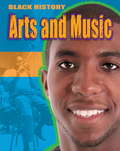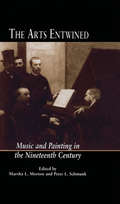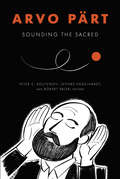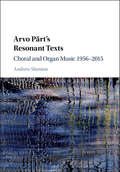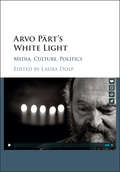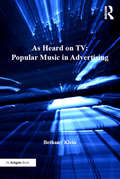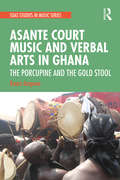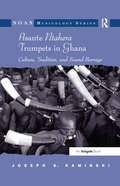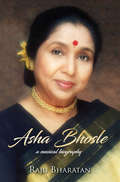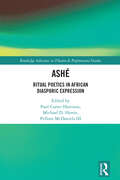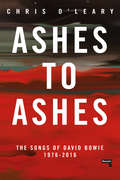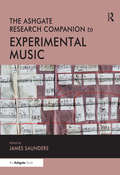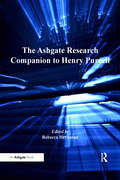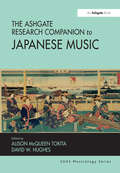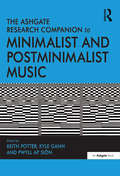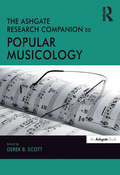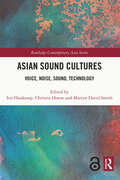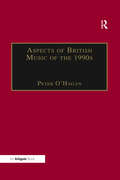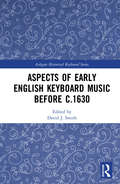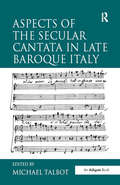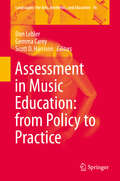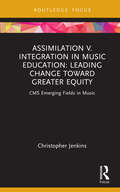- Table View
- List View
Arts and Music (Black History #2)
by Dan Lyndon-CohenWhether you enjoy listening to music, reading books and poetry, watching films or visiting art museums, the contributions made by artists and performers of African origin are all around you. Rising out of the shackles of slavery in centuries past, to increased recognition in this new century, it is clear that black people have made an enormous contribution to culture around the world. This book looks at the influences and key movements in the development of black artists and their work across the generations.The Black History series brings together a wide range of events and experiences from the past to promote knowledge and understanding of black culture today. This book looks at the influences and key movements in the development of black artists and their work across the generations.
The Arts Entwined: Music and Painting in the Nineteenth Century (Critical and Cultural Musicology)
by Marsha Morton Peter L. SchmunkThis collection of essays by musicologists and art historians explores the reciprocal influences between music and painting during the nineteenth century, a critical period of gestation when instrumental music was identified as the paradigmatic expressive art and theoretically aligned with painting in the formulation ut pictura musica (as with music, so with painting). Under music's influence, painting approached the threshold of abstraction; concurrently many composers cultivated pictorial effects in their music. Individual essays address such themes as visualization in music, the literary vs. pictorial basis of the symphonic poem, musical pictorialism in painting and lithography, and the influence of Wagner on the visual arts. In these and other ways, both composers and painters actively participated in interarts discourses in seeking to redefine the very identity and aims of their art. Also includes 17 musical examples.
Arvo Pärt: Sounding the Sacred
by Andrew Shenton Christopher May Andrew Albin Peter C. Bouteneff Maria Cizmic Jeffers Engelhardt Adriana Helbig Paul Hillier Kevin Karnes Alexander Lingas Ivan Moody Robert Saler Toomas Siitan Sevin YaramanScholarly writing on the music of Arvo Pärt is situated primarily in the fields of musicology, cultural and media studies, and, more recently, in terms of theology/spirituality. Arvo Pärt: Sounding the Sacred focuses on the representational dimensions of Pärt’s music (including the trope of silence), writing and listening past the fact that its storied effects and affects are carried first and foremost as vibrations through air, impressing themselves on the human body. In response, this ambitiously interdisciplinary volume asks: What of sound and materiality as embodiments of the sacred, as historically specific artifacts, and as elements of creation deeply linked to the human sensorium in Pärt studies? In taking up these questions, the book “de-Platonizes” Pärt studies by demystifying the notion of a single “Pärt sound.” It offers innovative, critical analyses of the historical contexts of Pärt’s experimentation, medievalism, and diverse creative work; it re-sounds the acoustic, theological, and representational grounds of silence in Pärt’s music; it listens with critical openness to the intersections of theology, sacred texts, and spirituality in Pärt’s music; and it positions sensing, performing bodies at the center of musical experience. Building on the conventional score-, biography-, and media-based approaches, this volume reframes Pärt studies around the materiality of sound, its sacredness, and its embodied resonances within secular spaces.
Arvo Pärt’s Resonant Texts: Choral and Organ Music 1956–2015
by Andrew ShentonStatistically the most performed and listened to contemporary composer in the world, Arvo Pärt is a musical and cultural phenomenon. This book is an essential resource for anyone interested in his extraordinarily innovative and uniquely appealing music. <P><P>Andrew Shenton surveys the full scope of Pärt's oeuvre, providing context and chronological continuity while concentrating in particular on his text-based music, analysing and describing individual pieces and techniques such as tintinnabulation. The book also explores the spiritual and theological contexts of Part's creativity, and the challenges of performing his work. This volume is the definitive guide for readers looking to engage with the form, content, and context of Pärt's compositions, as Shenton situates Pärt in the narrative of metamodernism and suggests new ways of understanding this unique and beautiful music.<P> This is the only book to explore the entire career of this extremely popular contemporary composer.<P> Includes numerous musical examples, enabling readers to understand the form, content, and context of individual pieces, as well as key innovative techniques such as tintinnabulation.<P> Suggests broader approaches to Christian texts, making Pärt's work accessible to a wider audience.<P>
Arvo Pärt’s White Light: Media, Culture, Politics
by Laura DolpOne of the most frequently performed contemporary composers, Arvo Pärt has become a phenomenon whose unusual reach is felt well beyond the concert hall. This ground-breaking collection of essays investigates both the causes and the effects of this success. Beyond the rhetoric of 'holy minimalism' that has accompanied the composer's reception since the mid-1980s, each chapter takes a fresh approach toward understanding how Pärt's music has occupied social landscapes. The result is a dynamic conversation among filmgoers (who explore issues of empathy and resemblance), concertgoers (commerce and art), listeners (embodiment, healing and the role of technology), activists (legacies of resistance) and performers (performance practice). Collectively, these studies offer a bold and thoughtful engagement with Pärt as a major cultural figure and reflect on the unprecedented impact of his music. Provides a wide range of in-depth perspectives on the reception and influence of one of the world's most popular contemporary composers Accessible to a wide range of scholars across the humanities as well as to music specialists, with a minimum of technical musical analysis Offers groundbreaking explorations of Pärt's impact on numerous areas of the cultural landscape, from film and performance to new media and politics
As Glenn as Can Be
by Sarah EllisA warm and witty portrait of child prodigy and world-famous classical musician Glenn Gould. Glenn was a child who knew his own mind — he liked boats but did not like fishing; he enjoyed puns and pranks but did not like bullying; he loved learning but did not like school … but more than anything else he loved to play the piano. Glenn had a professional performing career by the time he was fifteen; he gave concerts all over the world in his twenties. He became best known for his interpretation of Bach’s Goldberg Variations. But Glenn grew to dislike concerts — the hall was too cold, or he didn’t feel well, or the audience made too much noise (he didn’t even like their applause!). He discovered that when he played and recorded music in an empty concert hall, he could make it sound exactly the way he wanted. He could do what he loved best, while being completely himself. Sarah Ellis’s beautifully written portrait of Glenn Gould is complemented by Nancy Vo’s gorgeous illustrations, bringing the life and times of this extraordinarily talented musician to readers young and old. Includes a fascinating author’s note and resources for further information. Key Text Features additional information afterword author’s note bibliography biographical information biographical note explanation facts further information further reading historical context illustrations informational note photographs sources vignettes writing inspiration Correlates to the Common Core State Standards in English Language Arts: CCSS.ELA-LITERACY.RL.K.7 With prompting and support, describe the relationship between illustrations and the story in which they appear (e.g., what moment in a story an illustration depicts). CCSS.ELA-LITERACY.RL.1.2 Retell stories, including key details, and demonstrate understanding of their central message or lesson. CCSS.ELA-LITERACY.RL.1.7 Use illustrations and details in a story to describe its characters, setting, or events.
As Heard on TV: Popular Music In Advertising (Ashgate Popular and Folk Music Series)
by Bethany KleinThe use of popular music in advertising represents one of the most pervasive mergers of cultural and commercial objectives in the modern age. Steady public response to popular music in television commercials, ranging from the celebratory to the outraged, highlights both unresolved tensions around such partnerships and the need to unpack the complex issues behind everyday media practice. Through an analysis of press coverage and interviews with musicians, music supervisors, advertising creatives, and licensing managers, As Heard on TV considers the industrial changes that have provided a foundation for the increased use of popular music in advertising, and explores the critical issues and debates surrounding media alliances that blur cultural ambitions with commercial goals. The practice of licensing popular music for advertising revisits and continues a number of themes in cultural and media studies, among them the connection between authorship and ownership in popular music, the legitimization of advertising as art, industrial transformations in radio and music, the role of music in branding, and the restructuring of meaning that results from commercial exploitation of popular music. As Heard on TV addresses these topics by exploring cases involving artists from the Beatles to the Shins and various dominant corporations of the last half-century. As one example within a wider debate about the role of commerce in the production of culture, the use of popular music in advertising provides an entry point through which a range of practices can be understood and interrogated. This book attends to the relationship between popular culture and corporate power in its complicated variation: at times mutually beneficial and playfully suspicious of constructed boundaries, and at others conceived in strain and symbolic of the triumph of hypercommercialism.
As Thousands Cheer: The Life of Irving Berlin
by Laurence BergreenThis is the life story of Irving Berlin, from his arrival in the United States, through his childhood, and development as one of the country's greatest composers.
Asante Court Music and Verbal Arts in Ghana: The Porcupine and the Gold Stool (SOAS Studies in Music)
by Kwasi AmpeneAsante Court Music and Verbal Arts in Ghana is a comprehensive portrait of Asante court musical arts. Weaving together historical narratives with analyses of texts performed on drums, ivory trumpets, and a cane flute, the book includes a critical assembly of ancient song texts, the poetry of bards (kwadwom), and referential poetry performed by members of the constabulary (apae). The focus is on the intersections between lived experience, music, and values, and refers to musical examples drawn from court ceremonies, rituals, festivals, as well as casual performances elicited in the course of fieldwork. For the Asante, the performing arts are complex sites for recording and storing personal experiences, and they have done so for centuries with remarkable consistency and self-consciousness. This book draws on archaeological, archival, historical, ethnographical and analytical sources to craft a view of the Asante experience as manifested in its musical and allied arts. Its goal is to privilege the voices of the Asante and how they express their history, religious philosophy, social values, economic, and political experiences through the musical and allied arts. The author’s theoretical formulation includes the concept of value, referring to ideas, worldview concepts, beliefs, and social relationships that inform musical practices and choices in Asante.
Asante Ntahera Trumpets in Ghana: Culture, Tradition, and Sound Barrage (SOAS Studies in Music)
by Joseph S.KaminskiBased on the author's fieldwork in Ghana with the Asante and Denkyira ntahera trumpeters, this book draws on interviews, field recordings, oral traditions, written accounts, archaeological evidence, transcriptions and linguistic analyses to situate the Asante trumpet tradition in historical culture. There are seven ivory trumpet ensembles in residence at the Asante Manhyia Palace in Kumase, and ivory trumpets are blown at every Akan court. The Asante trumpets, which are made from elephant tusks, are symbols of Asante strength and have an important role in Asante cosmology. Surrogate speech is performed via lipped tones through a tusk in praise of the Asante royal ancestors and the living Asante king. This book contains transcriptions and analyses of surrogate speech texts and their accompanying ensemble songs. When several ensembles play simultaneously as a representation of power, they make staggered entrances, beginning separate songs in order. This results in a simultaneous performance of separate songs. This phenomenon, which Kaminski has termed 'sound-barrage', is an ancient aesthetic, and is performed to protect the kingdom and the ancestors. It is both spiritual and acoustical. This 'sound barrage' is believed to act in the metaphysical world, dispelling evil spirits from court rituals, ancestor venerations, and funerals, for there is a spirit in the sound.
Asha Bhosle: A Musical Biography
by Raju BharatanThe definitive saga, at once riveting and revelatory – studded with rare nuggets of information and fascinating anecdotes – that sparkingly brings out the life and times of an internationally acclaimed incredibly versatile singer. Asha Bhosle – a Guinness world record holder plus recipient of the Padma Vibhushan and the Dadasaheb Phalke Award – has held one and all spellbound for six decades now. Her voice, both fluid and flexible, has infused neo life into a variety of genres – from the melancholy melody to the rollicking rock-’n’-roll; from the soulful creation to the vibrant disco; from the romantic rhapsody to the rambunctious folk song; from the dainty ghazal to the boisterous qawwali; and from the pathos-filled rendition to the naughty-naugthy seductive number. The author – on the strength of his vast and varied exposure and experience – turns the focus on enthralling behind-the-scenes happenings that shaped the advance of this artiste with a remarkable range and a noteworthy body of work. ‘The world has no time for losers’ has remained Asha’s performing credo. This volume captures Asha Bhosle in her numberless shades. It is about how – in her silken rivalry with elder sister Lata Mangeshkar – she moved with panache from O. P. Nayyar to S. D. Burman to R. D. Burman. It is about how she served a galaxy of composers; about how, in the end, she reached the pinnacle all by herself. Against odds that would have driven any other woman into quitting. No quitter ever, Asha Bhosle, as the supernova supreme, just went on to underline the adage: ‘No power like woman power’. No more can you stay away from this marvel of a musical biography than you can stay away from the matchless musicality of Asha Bhosle. If she is one of a kind, so is this musical masterpiece capturing all the resonances and nuances going with her piquant persona. Here is a long-awaited career study shedding light on the twists and turns marking the starry-eyed world of Hindustani film music.
ASHÉ: Ritual Poetics in African Diasporic Expression (Routledge Advances in Theatre & Performance Studies)
by Paul Carter Harrison Michael D. Harris Pellom McDaniels III‘ASHÉ: Ritual Poetics in African Diasporic Expressivity' is a collection of interdisciplinary essays contributed by international scholars and practitioners. Having distinguished themselves across such disciplines as Anthropology, Art, Music, Literature, Dance, Philosophy, Religion, and Theology and conjoined to construct a defining approach to the study of Aesthetics throughout the African Diaspora with the Humanities at the core, this collection of essays will break new ground in the study of Black Aesthetics. This book will be of great interest to scholars, practitioners, and students interested in tracing African heritage identities throughout the African Diaspora through close examination of a variety of discourses directly connected to expressive elements of cultural production and religious rituals.
Ashes to Ashes: The Songs of David Bowie, 1976-2016
by Chris O'LearyFrom the ultimate David Bowie expert comes an exploration of the final four decades of his musical career, covering every song he wrote, performed or produced.From the ultimate David Bowie expert comes this exploration of the final four decades of the popstar's musical career, covering every song he wrote, performed or produced from 1976 to 2016.Starting with Low, the first of Bowie's Berlin albums, and finishing with Blackstar, his final masterpiece released just days before his death in 2016, each song is annotated in depth and explored in essays that touch upon the song's creation, production, influences and impact.
The Ashgate Research Companion to Experimental Music (Routledge Music Companions)
by James SaundersThe recent resurgence of experimental music has given rise to a more divergent range of practices than has previously been the case. The Ashgate Research Companion to Experimental Music reflects these recent developments by providing examples of current thinking and presenting detailed case studies that document the work of contemporary figures. The book examines fourteen current practitioners by interrogating their artistic practices through annotated interviews, contextualized by nine authored chapters which explore central issues that emerge from and inform these discussions. Whilst focusing on composition, the book also encompasses related aspects of performance, improvisation and sonic art. The interviews all explore how the selected artists work, focusing on the processes involved in developing their recent projects, set against more general aesthetic concerns. They aim to shed light on the disparate nature of current work whilst seeking to find possible points of contact. Many of the practitioners are active in areas that span disciplines, such as composition and improvisation, and the book explores the interaction of these activities in the context of their work. The other chapters consider a range of issues pertinent to recent developments in the genre, including: definitions of experimentalism and its relationship with a broader avant garde; experimentalism and cultural change; notation and its effect on composition; realising open scores; issues of notation and interpretation in live electronic music; performing experimental music; improvisation and technology; improvisation and social meaning; instrumentalizing objects; visual artists' relationships to experimental music; working across interdisciplinary boundaries; listening and the soundscape; working methods, techniques and aesthetics of recent experimental music.
The Ashgate Research Companion to Henry Purcell (Routledge Music Companions)
by Rebecca HerissoneThe Ashgate Research Companion to Henry Purcell provides a comprehensive and authoritative review of current research into Purcell and the environment of Restoration music, with contributions from leading experts in the field. Seen from the perspective of modern, interdisciplinary approaches to scholarship, the companion allows the reader to develop a rounded view of the environment in which Purcell lived, the people with whom he worked, the social conditions that influenced his activities, and the ways in which the modern perception of him has been affected by reception of his music after his death. In this sense the contributions do not privilege the individual over the environment: rather, they use the modern reader's familiarity with Purcell's music as a gateway into the broader Restoration world. Topics include a reassessment of our understanding of Purcell's sources and the transmission of his music; new ways of approaching the study of his creative methods; performance practice; the multi-faceted theatre environment in which his work was focused in the last five years of his life; the importance of the political and social contexts of late seventeenth-century England; and the ways in which the performance history and reception of his music have influenced modern appreciation of the composer. The book will be essential reading for anyone studying the music and culture of the seventeenth century.
The Ashgate Research Companion to Japanese Music (SOAS Studies in Music)
by David W. HughesMusic is a frequently neglected aspect of Japanese culture. It is in fact a highly problematic area, as the Japanese actively introduced Western music into their modern education system in the Meiji period (1868-1911), creating westernized melodies and instrumental instruction for Japanese children from kindergarten upwards. As a result, most Japanese now have a far greater familiarity with Western (or westernized) music than with traditional Japanese music. Traditional or classical Japanese music has become somewhat ghettoized, often known and practised only by small groups of people in social structures which have survived since the pre-modern era. Such marginalization of Japanese music is one of the less recognized costs of Japan's modernization. On the other hand, music in its westernized and modernized forms has an extremely important place in Japanese culture and society, Beethoven's Ninth Symphony, for example, being so widely known and performed that it is arguably part of contemporary Japanese popular and mass culture. Japan has become a world leader in the mass production of Western musical instruments and in innovative methodologies of music education (Yamaha and Suzuki). More recently, the Japanese craze of karaoke as a musical entertainment and as musical hardware has made an impact on the leisure and popular culture of many countries in Asia, Europe and the Americas. This is the first book to cover in detail all genres including court music, Buddhist chant, theatre music, chamber ensemble music and folk music, as well as contemporary music and the connections between music and society in various periods. The book is a collaborative effort, involving both Japanese and English speaking authors, and was conceived by the editors to form a balanced approach that comprehensively treats the full range of Japanese musical culture.
The Ashgate Research Companion to Minimalist and Postminimalist Music (Routledge Music Companions)
by Keith Potter Kyle GannIn recent years the music of minimalist composers such as La Monte Young, Terry Riley, Steve Reich and Philip Glass has, increasingly, become the subject of important musicological reflection, research and debate. Scholars have also been turning their attention to the work of lesser-known contemporaries such as Phill Niblock and Eliane Radigue, or to second and third generation minimalists such as John Adams, Louis Andriessen, Michael Nyman and William Duckworth, whose range of styles may undermine any sense of shared aesthetic approach but whose output is still to a large extent informed by the innovative work of their minimalist predecessors. Attempts have also been made by a number of academics to contextualise the work of composers who have moved in parallel with these developments while remaining resolutely outside its immediate environment, including such diverse figures as Karel Goeyvaerts, Robert Ashley, Arvo Pärt and Brian Eno. Theory has reflected practice in many respects, with the multimedia works of Reich and Glass encouraging interdisciplinary approaches, associations and interconnections. Minimalism’s role in culture and society has also become the subject of recent interest and debate, complementing existing scholarship, which addressed the subject from the perspective of historiography, analysis, aesthetics and philosophy. The Ashgate Research Companion to Minimalist and Postminimalist Music provides an authoritative overview of established research in this area, while also offering new and innovative approaches to the subject.
The Ashgate Research Companion to Popular Musicology (Routledge Music Companions)
by Derek B. ScottThe research presented in this volume is very recent, and the general approach is that of rethinking popular musicology: its purpose, its aims, and its methods. Contributors to the volume were asked to write something original and, at the same time, to provide an instructive example of a particular way of working and thinking. The essays have been written with a view to helping graduate students with research methodology and the application of relevant theoretical models. The team of contributors is an exceptionally strong one: it contains many of the pre-eminent academic figures involved in popular musicological research, and there is a spread of European, American, Asian, and Australasian scholars. The volume covers seven main themes: Film, Video and Multimedia; Technology and Studio Production; Gender and Sexuality; Identity and Ethnicity; Performance and Gesture; Reception and Scenes and The Music Industry and Globalization. The Ashgate Research Companion is designed to offer scholars and graduate students a comprehensive and authoritative state-of-the-art review of current research in a particular area. The companion's editor brings together a team of respected and experienced experts to write chapters on the key issues in their speciality, providing a comprehensive reference to the field.
Asian Sound Cultures: Voice, Noise, Sound, Technology (Routledge Contemporary Asia Series)
by Iris Haukamp Christin Hoene Martyn David SmithThis book examines the meanings, uses, and agency of voice, noise, sound, and sound technologies across Asia. Including a series of wide-ranging and interdisciplinary case studies, the book reveals sound as central to the experience of modernity in Asia and as essential to the understanding of the historical processes of cultural, social, political, and economic transformation throughout the long twentieth century. Presenting a broad range of topics – from the changing sounds of the Kyoto kimono making industry to radio in late colonial India – the book explores how the study of Asian sound cultures offers greater insight into historical accounts of local and global transformation. Challenging us to rethink and reassemble important categories in sound studies, this book will be a vital resource for students and scholars of sound studies, Asian studies, history, postcolonial studies, and media studies.
Aspects of British Music of the 1990s
by Peter O’haganThe 1990s work of six British composers forms the focus of this collection of essays, arising from a conference that took place at University of Surrey Roehampton in February 1999. The composers whose music is discussed are James Dillon, Thomas Ad Harrison Birtwistle, Jonathan Harvey, Edwin Roxburgh and Sebastian Forbes. Reflecting the aims of the conference, this volume brings together composers and musicologists to discuss significant works from the last decade of the twentieth century, and also some of the wider issues surrounding British music. Arnold Whittall and Julian Johnson provide perspectives on the plurality of contemporary British music. Edwin Roxburgh offers a personal account of 'The Artists' Dilemma', whilst the essays that follow explore aspects of musical form and structure in a variety of works. The second half of the book comprises interviews with most of the composers whose music is discussed in Part I, adding a further dimension to our understanding of the preoccupations of British composition at the end of the twentieth century.
Aspects of Early English Keyboard Music before c.1630 (Ashgate Historical Keyboard Series)
by David J. SmithEnglish keyboard music reached an unsurpassed level of sophistication in the late sixteenth and early seventeenth centuries as organists such as William Byrd and his students took a genre associated with domestic, amateur performance and treated it as seriously as vocal music. This book draws together important research on the music, its sources and the instruments on which it was played. There are two chapters on instruments: John Koster on the use of harpsichord during the period, and Dominic Gwynn on the construction of Tudor-style organs based on the surviving evidence we have for them. This leads to a section devoted to organ performance practice in a liturgical context, in which John Harper discusses what the use of organs pitched in F may imply about their use in alternation with vocal polyphony, and Magnus Williamson explores improvisational practice in the Tudor period. The next section is on sources and repertoire, beginning with Frauke Jürgensen and Rachelle Taylor’s chapter on Clarifica me Pater settings, which grows naturally out of the consideration of improvisation in the previous chapter. The next two contributions focus on two of the most important individual manuscript sources: Tihomir Popović challenges assumptions about My Ladye Nevells Booke by reflecting on what the manuscript can tell us about aristocratic culture, and David J. Smith provides a detailed study of the famous Fitzwilliam Virginal Book. The discussion then broadens out into Pieter Dirksen’s consideration of a wider selection of sources relating to John Bull, which in turn connects closely to David Leadbetter’s work on Gibbons, lute sources and questions of style.
Aspects of the Secular Cantata in Late Baroque Italy
by Michael TalbotAs shown by the ever-increasing volume of recordings, editions and performances of the vast repertory of secular cantatas for solo voice produced, primarily in Italy, in the second half of the seventeenth century and the first half of the eighteenth century, this long neglected genre has at last 'come of age'. However, scholarly interest is currently lagging behind musical practice: incredibly, there has been no general study of the Baroque cantata since Eugen Schmitz's handbook of 1914, and although many academic theses have examined microscopically the cantatas of individual composers, there has been little opportunity to view these against the broader canvas of the genre as a whole. The contributors in this volume choose aspects of the cantata relevant to their special interests in order to say new things about the works, whether historical, analytical, bibliographical, discographical or performance-based. The prime focus is on Italian-born composers working between 1650 and 1750 (thus not Handel), but the opportunity is also taken in one chapter (by Graham Sadler) to compare the French cantata tradition with its Italian parent in association with a startling new claim regarding the intended instrumentation. Many key figures are considered, among them Tomaso Albinoni, Giovanni Bononcini, Giovanni Legrenzi, Benedetto Marcello, Alessandro Scarlatti, Alessandro Stradella, Leonardo Vinci and Antonio Vivaldi. The poetic texts of the cantatas, all too often treated as being of little intrinsic interest, are given their due weight. Space is also found for discussions of the history of Baroque solo cantatas on disc and of the realization of the continuo in cantata arias - a topic more complex and contentious than may at first be apparent. The book aims to stimulate interest in, and to win converts to, this genre, which in its day equalled the instrumental sonata in importance, and in which more than a few composers invested a major part of their creativity.
Assessment in Music Education: From Policy To Practice (Landscapes: the Arts, Aesthetics, and Education #16)
by Scott D. Harrison Don Lebler Gemma CareyThe contributions to this volume aim to stimulate discussion about the role of assessment in the learning experiences of students in music and other creative and performing arts settings. The articles offer insights on how assessment can be employed in the learning setting to enhance outcomes for students both during their studies at higher education institutions and after graduation. An international group of leading researchers offers an exciting array of papers that focus on the practice of assessment in music, particularly in higher education settings. Contributions reflect on self-, peer- and alternative assessment practices in this environment. There is a particular emphasis on the alignment between assessment, curriculum structure and pedagogy.
Assimilation v. Integration in Music Education: Leading Change toward Greater Equity (CMS Emerging Fields in Music)
by Christopher JenkinsAssimilation v. Integration in Music Education engages with an existential question for American conservatories and orchestras: What does it mean to diversify Western classical music? Many institutions have focused solely on diversifying the demography of their participants, but without a deeper conversation about structural oppression in classical music, this approach continues to isolate and exclude students of color. Rooted in the author’s experience working with BIPOC (Black, Indigenous, and People of Color) students at a major American conservatory, this book articulates the issues facing minority students in conservatories and schools of music, going beyond recruitment to address the cultural issues that alienate students. The author argues that the issue of diversity should be approached through the lens of aesthetics, and that the performance and pedagogy of Western classical music must change if a more diverse membership is to thrive in this genre. Reflecting on the author’s experience through the lens of recent critical theory in music education, this volume presents the viewpoints of Black and Latinx music students in their own words. Addressing the impact of racialized aesthetics on the well-being of BIPOC music students, the author shows how students are alienated when attempting to assimilate into conservatory environments and envisions an alternative, integrative approach to conservatory education. Offering a deep dive into the psychological and cultural reasons for the racialization of Western classical music, and potential institutional solutions, this concise book is relevant to performers, students, and institutional leaders.
Assistant Engineers Handbook: The Definitive Guide To Working As An Assistant Engineer In Today's Modern Recording Studio
by Tim CrichAssistant Engineers Handbook: The Definitive Guide to Working as an Assistant Recording Engineer in Today's Modern Sound Studio
